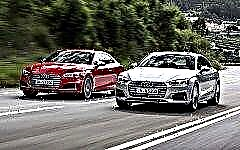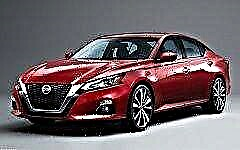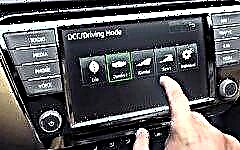

The content of the article:
- What it is
- Suspension device
- Principle of operation
- Pros and cons
- The main differences
- Where is found
- Scheme
- Breakdown and repair cost
The car's suspension is considered one of the main components responsible for comfort and mobility. As a rule, it is a collection of several elements, nodes and elements, each of which performs its own important role. Before that, we had already considered the MacPherson system, multi-link and torsion bar, so there is something to compare and understand how much comfort is better or worse, whether repairs are cheap or expensive, as well as how the adaptive suspension works and how it works.
What is adaptive suspension

From the very name that the suspension is adaptive, it becomes clear that the system can automatically or through the commands of the on-board computer change certain characteristics, parameters and adapt to the requirements of the driver or the road surface. In some manufacturers, this version of the mechanism is also found under the name semi-active.
The main characteristic of the entire mechanism is the degree of damping of the shock absorbers (the rate of damping of vibrations and the minimization of the transmission of shocks to the body). The first mentions of the adaptive mechanism have been known since the 50s of the twentieth century. Then manufacturers began to use hydropneumatic struts, instead of traditional shock absorbers and springs. Hydraulic cylinders and accumulators in the form of spheres served as the basis. The principle of operation was quite simple, due to changes in fluid pressure, the parameters of the base and chassis of the car changed.
The first car on which a hydropneumatic strut was encountered was Citroen, released in 1954.
Later, the same mechanism was used for DS cars, and starting from the 90s, the Hydractive suspension appeared, which engineers still use and refine to this day. By adding electronics and automatic control systems, the mechanism can independently adapt to the road surface or the driver's driving style. Thus, it is clear that the main part of the adaptive mechanism today is considered to be electronics and hydropneumatic struts, which can change characteristics based on different sensors and analysis of the on-board computer.
How does an adaptive car suspension work?

Depending on the manufacturer, the suspension can be modified and change component parts, but there are those elements that will be standard for all variants. As a rule, this set includes:
- electronic control unit;
- active racks (adjustable car racks);
- anti-roll bars with adjustment function;
- various sensors (unevenness of the road, body roll, clearance and others).
Each of the listed elements bears significant responsibility in the functionality of the adaptive car system. Electronic control unit the car's suspension is considered the heart of the mechanism, it is he who is responsible for the selection of the mode and the setting of individual mechanisms. As a rule, he analyzes the information collected from different sensors, or he receives a command from the manual unit (the selector controlled by the driver). Depending on the type of signal received, the stiffness correction will be automatic (in the case of collecting information from sensors) or forced (at the command of the driver).

In the photo, the anti-roll bar with electronic adjustment
The essence of the work stabilizer with electronic adjustment the same as in a conventional anti-roll bar, only the difference is in the possibility of adjusting the degree of rigidity, depending on the command of the control unit. It is often triggered when the vehicle is maneuvering, thereby reducing body roll. The control unit is able to calculate signals in milliseconds, which allows you to instantly respond to road irregularities and different situations.
Sensors for an adaptive base car - usually special devices, the purpose of which is to measure and collect information and transfer it to the central control unit. For example, the acceleration sensor of the car collects data on the quality of the expensive, and at the moment of body swing, it is triggered and transmits the information to the control unit.
The second sensor is a road roughness sensor, it reacts to irregularities and transmits information about the vertical oscillation of the car body. Many consider him to be the main one, since he is responsible for further adjustment of the racks. Equally important is the vehicle body position sensor, it is responsible for the horizontal position and, during maneuvers, transmits data on the tilt of the body (when braking or accelerating). Often, in such a situation, the car body tilts forward when braking hard, or backward when accelerating.

Pictured are adjustable adaptive suspension struts.
The last piece of the adaptive system is adjustable (active) racks... These elements quickly react to the road surface, as well as to the style of movement of the vehicle. Due to changes in fluid pressure inside, the stiffness of the suspension as a whole also changes. Experts distinguish two main types of active racks: with a magnetic rheological fluid and with an electromagnetic valve.
The first variant of active racks filled with special liquid. The viscosity of a liquid can vary depending on the strength of the electromagnetic field. The higher the resistance of fluid to passing through the valve, the more rigid the car's base will be. These racks are used in Cadillac and Chevrolet (MagneRide) or Audi (Magnetic Ride) vehicles.Stands with solenoid valve change their stiffness by opening or closing the valve (variable section valve). Depending on the command of the control unit, the cross-section changes, and the stiffness of the struts changes accordingly. This type of mechanism can be found on the suspensions of Volkswagen (DCC), Mercedes-Benz (ADS), Toyota (AVS), Opel (CDS) and BMW (EDC) vehicles.
How Adaptive Vehicle Suspension Works

It is one thing to disassemble the basic elements of an adaptive suspension, but it is another thing to understand how it works. After all, it is the very principle of operation that will give an idea of the possibilities and use cases. To begin with, consider the option of automatic suspension control, when the on-board computer and the electronic control unit are responsible for the level of stiffness and settings. In such a situation, the system collects all information from the ride height, acceleration and other sensors, and then transmits everything to the control unit.
The latter analyzes the information and draws conclusions about the condition of the road surface, the driver's driving style and other characteristics of the car. In accordance with the conclusions, the unit transmits commands to adjust the stiffness of the struts, control the anti-roll bar, as well as other elements that are responsible for the comfort in the cabin and are tied to the work of the adaptive base of the car. It should be understood that all elements and parts are interconnected and work not only to receive commands, but also respond to the state, commands worked out and the need to correct certain nodes. It turns out that the system, in addition to transmitting programmed commands, also learns (adapts) to the requirements of the driver or the unevenness of the road.

In contrast to the automatic control of the adaptive suspension of the machine, the manual control differs in the principle of operation.Experts distinguish two main areas: the first is when the driver forcibly sets the stiffness by adjusting the struts (using the regulators in the car interior). Second option semi-manual or semi-automatic, since initially the modes are sewn into a special block, and the driver can only choose the mode of movement. Accordingly, the electronic unit of the adaptive suspension transmits commands to the mechanisms in order to establish the rigidity of the mechanism. In this case, the information from the sensors is read minimally, more often it is used to adjust the existing parameters in order to make the base as comfortable as possible for certain road surface conditions. Among the most common tuning modes, there are: normal, sporty, comfortable and for off-road driving.
Pros and cons of adaptive car suspension

No matter how ideally the mechanism is arranged, there will always be a positive and negative side (pros and cons). The adaptive suspension of the car is no exception, despite the fact that many experts only talk about the advantages of mechanisms.
| Pros and cons of adaptive car suspension | |
| Benefits | disadvantages |
| Excellent ride quality | High production cost |
| Good handling of the car (even on a bad road) | High cost of suspension repair and maintenance |
| The ability to change the clearance of the car | Complexity of construction |
| Adaptation to road conditions | Complexity of repair |
| Selecting a travel mode | Pair replacement of hydropneumatic elements on one axis |
| Long service life of hydropneumatic elements (about 25,000 km of total mileage) | — |
We see that the main problem of the adaptive base of the car is the high cost of its maintenance, repair and production. In addition, the design is not very simple. Failure of one of the sensors will immediately affect the comfort and adjustment of the mechanism. A huge plus is the electronics, which reacts in a split second, thereby creating ideal conditions for the smooth running of the car body.
The main differences of the adaptive suspension

Comparing the above-described adaptive suspension device and others, such as multi-link or MacPherson, the differences can be noticed even without special skills in the field of car design. For example, McPherson, although comfortable, but the intersection between good and bad road surface will be felt by passengers in the car. The controllability of such a suspension on a bad road is lost and is not always the best in the case of off-road driving.
As for the adaptive, the driver, in fact, may not understand when the car hit the bad road surface. The system adjusts at lightning speed, changes the control conditions and the stiffness of the racks. The sensors become more sensitive, and the racks react more quickly to the commands of the electronic control unit.
In terms of the structure of the mechanism, in addition to specific racks, the system is distinguished by a variety of sensors, the very arrangement of parts, as well as a cumbersome view, which is easy to notice by looking behind the wheel of a car. It is worth noting that such a car suspension is constantly evolving and it makes no sense to talk about a specific structure or differences. Engineers from different manufacturers take into account the shortcomings, making expensive parts cheaper, longer service life and expand capabilities. If we talk about the similarities with other well-known suspensions, then the adaptive system is most suitable for the structure of a multi-link, or double wishbone.
What cars are fitted with adaptive suspension

Finding a car with an adaptive suspension is much easier today than it was 10 years ago. We can say that many premium cars or SUVs are equipped with a similar mechanism. Of course, this is a plus to the cost of the car, but also a plus to comfort and control. Among the most popular models are:
- Toyota Land Cruiser Prado;
- Audi Q7;
- BMW X5;
- Mercedes-Benz GL-Class;
- Volkswagen Touareg;
- Opel Movano;
- BMW 3-Series;
- Lexus GX 460;
- Volkswagen Caravelle.
Naturally, this is the minimum list of cars that can be found on the street in any city. Due to its excellent qualities of comfort and ability to adapt to the road, the adaptive base is becoming more and more popular.
Diagram of the adaptive car suspension device

The photo shows a diagram of the adaptive suspension of the Audi Q7
- Front axle sensor;
- Body level sensor (front left);
- Body acceleration sensor (front left);
- Receiver 2;
- Level sensor, rear;
- Rear axle damper;
- Body acceleration sensor, rear;
- Receiver 1;
- Adaptive suspension control unit;
- Button for controlling the clearance in the trunk of a car;
- Air supply unit with valve block;
- Body acceleration sensor, front right;
- Right front level sensor.
The main breakdown options and the price of suspension parts

Like any mechanism, such a suspension breaks down over time, besides taking into account its careful operating conditions. It is very difficult to predict what exactly will fail in such a mechanism, according to various sources, the racks, all kinds of connecting elements (hoses, connectors and rubber bushings), as well as sensors responsible for collecting information, wear out the fastest.
A typical breakdown of the adaptive base of the machine can be a variety of sensor errors. In the cabin, there is discomfort, rumbling, or all the unevenness of the road surface is felt at all. Another characteristic breakdown can be the low ground clearance of the car, which cannot be adjusted. Most often this is a breakdown of adaptive struts, cylinders or containers responsible for pressure. The car will simply always be understated, and there will be no talk of comfort and handling at all.

In accordance with the breakdown of the adaptive suspension of the car, the price of parts for repair will be different. A huge disadvantage is that the repair of such a mechanism is urgent and in the event of a breakdown, it must be eliminated in the near future. In the classic and most common variants, the breakdown of shock absorbers or other parts allows it to drive for some time without repairs. To understand how much it will cost to repair, consider the price of the main parts of the 2012 Audi Q7.
| Audi Q7 2012 Adaptive Suspension Parts Cost | |
| Name | Price from, rub. |
| Front shock absorbers | 16990 |
| Rear shock absorbers | 17000 |
| Ride height sensor | 8029 |
| Rack pressure valve | 1888 |
The prices are not the lowest, although there are rumors that some parts are subject to repair. Therefore, before you run to buy a new part and if you want to save money, look on the Internet to see if it is possible to return it to a "combat state". According to statistics and taking into account the road surface, adaptive shock absorbers and sensors most often fail. Shock absorbers due to all kinds of damage and shock, sensors more often due to operating conditions in mud and frequent shocks on a bad road.
On the modern adaptive basis of the car, we can say that on the one hand it is an ideal option for comfort and driving. On the other hand, it is a very expensive pleasure that requires some care and timely repair. Such a basis can most often be found on expensive, premium cars, where comfort is paramount. According to many drivers, such a mechanism is ideal for off-road train travel, for long distances, or when, well, silence in the cabin of your car is very necessary.











